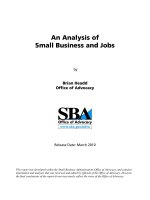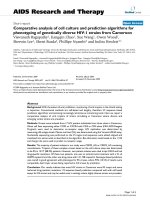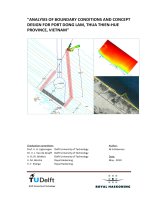An analysis of actual situation and some suggestions on overall buniness strategy and stategic solutions for company 185 - Truong Son construction corperation
Bạn đang xem bản rút gọn của tài liệu. Xem và tải ngay bản đầy đủ của tài liệu tại đây (1023.71 KB, 85 trang )
CAPSTONE PROJECT REPORT
AN ANALYSIS OF ACTUAL SITUATION AND SOME
SUGGESTIONS ON OVERALL BUNINESS STRATEGY
AND STATEGIC SOLUTIONS FOR COMPANY 185 –
TRUONG SON CONSTRUCTION CORPERATION
Group 1 – Class V02
Student’s name:
Hồng Mạnh Hùng
Ngơ Anh Tuấn
Hồ Nghĩa Đức
Lê Thị Hồng Lĩnh
VINH 2010
Acknowledgements
We wish to express our deepest gratitude to our lecturers for sharing their
expertise in their lectures and giving us their indispensable intellectual and scholarly
support during the completion of the report. Their profound knowledge of
theoretical and practical issues concerning our topic is a great source of inspiration
to us.
Our gratitude is also extended to the Board of Directors of Company 185 –
Truong Son Construction Corporation for their coordination and helping us in
collecting information about the Company without which we could not complete the
report.
We also extend our sincere thanks to our classmates and colleagues for their
assistance and encouragement.
i
TABLE OF CONTENTS
Ackowledgements
List of Diagrams
List of Tables
INTRODUCTION
1.
The rationale for choosing the topic:
2.
Subject and Scope of the Study
3.
Study Methods
4.
Design the assignment
CHAPTER 1:THEORIES OF BUSINESS STRATEGIES
Definition, features and role of business strategy in
1.1
enterprise
1.1.1
Definition of business strategies
1.1.2
Features of business strategy:
1.1.3
The role of business strategy
1.2
Business strategy administration process
1.2.1
Analysis of situation
1.2.2
Build up strategy
1.2.3
Strategy implementation
1.2.4
Strategy assessment
1.2.5
Requirement of business strategy construction
1.3
Define duty and system of strategic targets :
1.3.1
Strategic duty
1.3.2
System of strategic targets
1.3.3
Principle in target definition
1.4
Analysis of business environment of enterprise
1.4.1
Analysis of macro environment
1.4.1.1 Economic environment
1.4.1.2 Technological environment
1.4.1.3 Social and cultural environment
1.4.1.4 Natural environment
1.4.1.5 Governmental, legal and political envrionment
1.4.2
Analysis of sector environment (operational environment)
1.4.2.1 Analysis of current competitive opponents
1.4.2.2 Analysis of potential competitive opponents
1.4.2.3 Pressure from providers
1.4.2.4 Pressure of customers
1.4.2.5 Replaced products
1.4.3
Analysis of internal environment
1.4.3.1 Factors of human resource and organization
ii
Page
i
v
vi
1
1
2
2
3
4
4
4
5
6
7
7
7
8
8
8
9
9
10
10
10
12
12
13
13
14
14
15
15
16
17
17
18
18
19
1.4.3.2 Research and development factor (R&D)
1.4.3.3 Financial accounting factors
1.4.3.4 Production and technical factors
1.4.3.5 Marketing and product consumption factors
1.4.4
Analysis of international environment of enterprise
1.5
Distinguish business form
1.5.1
general business strategy
1.5.1.1 Focused growth strategy
1.5.1.2 Integrated growth strategy
1.5.1.3 Diversification strategy
1.5.1.4 Joint venture and association strategy
1.5.1.5 Reduction strategy
1.5.1.6 Mixed strategy
1.5.2
Division business strategy (function)
1.5.2.1 Product production strategy
1.5.2.2 Financial strategy
1.5.2.3 Human resource and organizational struc
1.5.2.4 Marketing strategy
1.6
Methods to analyze and choose strategies
1.6.1
BCG matrix
1.6.2
McKinsey - GE (General Electric)
1.6.3
SWOT analysis and strategic combination
CHAPTER 2: ANALYSIS OF FACTORS AFFECTING BUSINESS
ACTIVITIES OF COMPANY 185 – TRUONG SON
CONSTRUCTION CORPORATION
2.1
General introduction of Company 185
2.1.1
Establishment and development of the Company
2.1.2
Business sectors, targets and operational scope
2.1.3
Organizational structure of company
2.1.4
Business results of the Company
2.2
Analysis of business environment of the Company
2.2.1
Macro environment
2.2.1.1 Economic environment
2.2.1.2 Legal and political environment
2.2.1.3 Natural environment
2.2.1.4 Technological environment
2.2.1.5 Social and cultural environment
2.2.2
Operational environment
2.2.2.1 Current competitive opponents
2.2.2.2 Potential competitive opponents
iii
19
19
20
20
20
21
22
22
24
25
25
26
26
27
27
29
29
29
30
30
30
32
33
33
33
34
35
37
37
38
38
40
41
41
42
42
42
44
2.2.2.3 Providers
2.2.2.4 Customers
2.2.2.5 Replaced products
2.2.3
Internal environment
2.2.3.1 Resources
2.2.3.2 Organizational capacity of the company
2.2.3.3 Competitiveness analysis of the company
2.3
Setting up matrix
2.3.1
BCG Model
2.3.2
Mc.Kinsey – General Electric Matrix (Business strategy net)
2.3.3
SWOT Matrix (Only main factors are synthesized)
CHAPTER 3: SOME SUGGESTIONS ON OVERALL BUSINESS
TRATEGY AND STRATEGIC SOLUTIONS FOR THE
COMPANY
3.1
Basis for planning strategy
3.1.1
Strategic tasks of the Company
3.1.2
Strategic targets of the Company
3.1.3
Selection of strategy
3.2
General Business Strategy
3.2.1
Focused Growth Strategy
3.2.1.1 Market penetration
3.2.1.2 Market Development
3.2.2
Co-centre Diversification Strategy
3.3
Some Strategic Solutions
3.3.1
Improve quality of human resource
3.3.1.1
3.3.1.2
3.3.1.3
3.3.2
Improve professional qualifications
Increase quality of working life
Policy of salary and reward
Promote marketing activities
3.3.3
Raise capacity of capital
3.3.4
Renovate the management of production
CONCLUSION
REFERENCES
iv
44
44
46
48
48
55
56
58
58
60
62
65
65
65
65
66
66
66
67
68
69
69
69
70
72
72
73
74
75
76
78
List of Diagrams
Page
Diagram 1: Model of Business Environment of Enterprise
11
Diagram 2: Model of 5 forces of M.PORTER
14
Diagram 3: Strategic Matrix of MC.KINSEY - GE
30
Diagram 4: SWOT Matrix
31
Diagram 5 - Organizational Diagram of Company 185
34
Diagram 6: Production Process
50
Diagram 7 : BCG Matrix
57
Diagram 8 : Mc.Kisney Matrix
59
v
List of Tables
Page
Table 1: Some Main Norms Reached by the Company within Five
36
Recent Years
Table 2: Opportunities and Threats
45
Table 3: Labor Structure of the Company
47
Table 4: Some Financial Norms in 2009 of the Company
49
Table 5: Machines and Equipment of Company 185
52
Table 6: Competitive Image Matrix
54
Table 7: Company’s Strengths and Weaknesses
55
Table 8: Growth Rates and Relative Market Share for Business Items
56
of Company 185
Table 9: The Company’s Business Strengths
58
Table 10: Construction Industry Attractiveness
59
Table 11: SWOT Analysis
60
Table 12: Targets (million VN dong) in 2015
63
vi
INTRODUCTION
1.
The rationale for choosing the topic:
In the current situation in which Vietnam has shifted to a market economy,
enterprises have strongly divided into strong and weak ones and competition among
the enterprises has become more vigorous. To preserve and develop business,
enterprises must define a right strategy, as an inappropriate strategy may lead to a
failure.
Activities of enterprises in the market economy are to invest, use resources to
compete with opponents to get market share. The purpose of enterprises’ activities
in the market economy are to reach the possible highest effectiveness for a long
time. An enterprise’s operational effectiveness is the correlative results between
profit from business activities of the enterprise and mobilized resources for such
profit. For an enterprise, building up a right strategy can have a special significance;
timely strategy orientation and strategy adjustment can bring high profit for the
enterprise.
In the globalization of the market, technology always changes, competition is
more and more violent, and strategy has become a really important factor. Together
with scarceness of resources, demand and tastes of social consumption frequently
change which make business activities of enterprises more complex and risky. To
exist and develop, enterprises must build up a strategy.
Strategy is a special kind of plan that all organizations must design. For
enterprises, planning is the first function in system of management functions to
reach given purposes of the organization.
Defining strategy must be considered with regard to many objective external
factors and subjective internal factors of an enterprise, analyzing systematically
related information to define activities of the enterprise in short and long term, and
1
focusing all efforts and resources on main targets so as to meet the highest
effectiveness, cope with unexpected situations, adapt to the changes.
Company 185 – Truong Son Construction Corporation (henceforth referred
to as Company) is a unit in the construction sector. From the beginning years of
operation, Company has experienced many successes and failures and has gained
certain achievements. It has been well proved in reality that without defining a right
strategy, Company can go into traps which is hard for it to get out, then business
effectiveness will be reduced, even bankruptcy. Therefore, to continue standing in
the market and adapting to business environment, Company must build up an
appropriate strategy.
Originated from the importance of planning business strategy for enterprises
together with the demand of Company 185 – Truong Son Construction Corporation
in defining an appropriate strategy; Group 1 has chosen the topic “An Analysis of
Actual Situation and Some Suggestions on Overall Business Strategy and
Strategic Solutions for Company 185 – Truong Son Construction Cooperation”
with the expectation to work out a right orientation for the Company in the future.
2.
Subject and Scope of the Study
Applying theories and methodologies on business strategy, the assignment
will find out bases to plan business strategy for Company 185 - Truong Son
Construction Corporation.
Subject of the study: the topic will carry out an analysis, assessment
suggesting business strategy for the Company based on common theories of
planning strategy for enterprises.
Scope of the study:
- Theoretical issues on strategies of enterprises,
- Bases to form strategies of enterprise,
- Building business strategies for Company in short and long term and
solutions to implement those strategies.
3.
Study Methods
2
The study is based on methods such as statistics, synthesis, analysis, contrast,
modeling and estimating as well as learned knowledge to carry out analysis and
provide assessments of the whole business activities of Company 185 – Truong Son
Construction Corporation, and suggest strategies for the Company.
4.
Design the assignment
Apart from the preface, the conclusion and references, the main content of
the assignment is divided into three chapters:
Chapter I:
Theories of Business Strategies
Chapter II: An Analysis of Factors Affecting Business Activities of
Company 185 – Truong Son Construction Corporation
Chapter III: Some Suggestions on Overall Business Strategy and Strategic
Solutions for the Company
3
CHAPTER 1
THEORIES OF BUSINESS STRATEGIES
1.1
Definition, features and role of business strategy in enterprise
1.1.1 Definition of business strategies
Business strategy is a concern of many economists who have studied and
found out many different definitions of business strategy such as:
-
It is associated decisions, actions or plans which are designed to implement
organizational targets.
-
It is the result of the process of planning strategies.
-
It is the art to build up competitive advantage.
-
It is the collection of decisions and actions oriented to the targets which
make organizational capacity and resources meet the external opportunities and
threats.
-
According
to
Alfred
Chandker:
“Business
strategy
includes
the
determination of long term basic targets, at the same time choose the method of
action and allocate necessary resources to implement such targets”.
-
According to Wiliam.J.Gluech: “business strategy is a plan with high
consistency, comprehensiveness and coordination which are designed to ensure
basis targets to be done”
Besides, business strategy or competitive strategy is also defined according to
the following 6 factors.
First is product market. Opportunities of an enterprise depend on its own
products, its serving market, competitive opponents that it copes with and its own
integration level.
Second is investment level. We should choose the following capacity: invest
to expand or to penetrate into product market, or invest to maintain current position,
or minimize investment to withdraw, or liquidate to dissolve enterprise.
4
Third is functional strategy. Competitiveness can be focused on the
following functions: product strategy, position strategy, price strategy, allocation
strategy, production strategy, informatics strategy, segmentation strategy and
globalization strategy.
Fourth is strategic asset and strategic capacity. Strategic capacity is the
dominant aspect of enterprise; strategic asset is the resource power of enterprise
compared to other opponents. When setting up strategies, we must focus on cost as
well as the ability to create/maintain asset and capacity to be the basis for long term
competitive advantage.
Next is resource allocation. Financial resources and non-financial resources
such as factories, equipments, human must be allocated. Decision on allocation is
the essential factor for strategy.
The final factor is cooperation among enterprises. Only enterprises with
cooperation can have dominant advantage compared to such enterprises which skip
or do not exploit cooperation.
In general, strategy is the collection of actions and decisions related to each
other which helps an organization to reach its given targets, and it must be built in
such a way that it can exploit basic strengths including resources and capacity of the
organization as well as consider opportunities and threats of the environment.
Business strategy is recognized as a principle, a guideline in trading.
Therefore, an enterprise which wants to be successful in trading must have good
business strategy and effective implementation of that strategy.
1.1.2 Features of business strategy:
In spite of many different definitions and approaches to the category of
strategy, basic features of business strategy are considered consistently. Basic
features are as follow.
5
Firstly, business strategy has long term orientation which can point out
targets and business orientation for each sector and product as well as define basic
duty, solutions and steps to reach given targets.
Secondly, business strategy has flexibility because it is based on prediction
of future market which will always change. To make business strategy appropriate
so as to help an enterprise to reach its targets, it must be flexible in the changes of
market.
Thirdly, business strategy is built up according to long term (5 years to 10
years). Therefore business strategy is itinerary. When a long term strategy has been
set up, it will be concretized by shorter-term strategies which are called plans.
Next, business strategy is a constant process from planning to
implementation, monitoring and checking.
What is more, business strategy always attacks to win in competition.
Business strategy is formed and implemented based on discovering and exploiting
business opportunities and advantages of enterprise to reach high business effects.
Last but not least, all important strategic decisions in forming,
implementation, assessment and adjustment of strategy will focus on administrative
group to ensure accuracy of long term decisions and secret information in
competition.
From the above definitions and features, we can simply understand:
“business strategy is the process of defining general targets to develop enterprise
and use technical factors, business organization to win in competition and to reach
given targets”.
1.1.3 The role of business strategy
The market economy always changes; to exist and develop an enterprise
must be adapted to such changes. Modern business administration supposes that an
enterprise cannot cope with market change if it has no strategy of business and
development that represents its competitiveness and dynamic. Only on that basis
6
can the enterprise discover opportunities and threats to have suitable solutions. Lack
of a right business strategy can make enterprise passive and uncompetitive. Lack of
business strategy can make enterprise have ineffective business effect and even
bankruptcy.
Business strategy helps enterprises to define orientation in the future by their
own efforts. It also helps enterprises to define basic targets to reach in each period
and levels and define activities which can exploit and use resources, promote
advantage and grasp opportunities to occupy advantage in competition.
Besides, process of construction of business strategy based on monitoring
constantly happened events in and out of enterprise is to grasp change trend of
market; together with implementation of business strategy, it will help enterprises to
adapt to market, and even change operational environment to occupy competitive
advantage, reach high profit, increase productivity, improve environment and image
of enterprises within the market.
1.2
Business strategy administration process
In such process, administrators will implement the following activities.
1.2.1 Analysis of situation
Before making decision of orientation or reaction we must analyze current
situation; situation analysis will require considering organizational background,
internal and external environmental aspects:
Internal factors of an enterprise need to be considered to see whether they are
strong or weak.
External factors of an enterprise are considered to see whether they serve as
opportunities or threats for the enterprise.
Expectation of leader is the value of the enterprise, the prestige and the
competitive advantage.
1.2.2 Build up strategy
7
Building up business strategy includes designing and choosing suitable
strategy for an organization. To implement this we must consider many
organizational levels and suggest strategic forms.
In the first place, the company’s strategy cares for big and long term
problems such as: activities, trading sector, activities of trading sectors. Any change
of trading sector structure can change strategy of company.
Second is functional strategy which includes decisions and actions that orient
to short term target of different functional divisions in an organization such as
production, marketing, study and development, personnel, financial accounting, and
informatics technology.
Third is competitive strategy which studies competitive advantages that
organization wish to have and consider how the organization will compete in a
trading sector.
1.2.3
Strategy implementation
Planning of strategy is not enough for employees of an organization. The
strategy must be implemented. The implementation of strategy is the process to give
different strategies to be implemented. Methods for strategy implementation will be
connected with strategy planning.
1.2.4
Strategy assessment
The final period of strategy management is to assess strategy. All strategies
will depend on future changes because internal and external factors can change
constantly. Three main activities of such period including (1) consider factors as the
basis for current strategy; (2) measure achievements (3) implement adjusted
activities. Strategy assessment is necessary because current success cannot ensure a
similar success in the future; success can create new problems.
1.2.5 Requirement of business strategy construction
In business strategy construction, we must focus on the following features.
8
Firstly, business strategy must be connected with market. Enterprises will
build up business strategy based on investigation, study of market demand and
exploit opportunities, resources for producing products with suitable quantity,
quality, type and time; we can consider “strategy must indicate market controlling
of enterprise” as the principle and guideline for strategic administration. In addition,
construction of business strategy must increase advantage of enterprise, occupy
competitive advantage in the market. Besides, strategy must be expressed high
flexibility then construction of strategy just mentions general problems.
Secondly, when building business strategy we must consider safe area in
trading, limit risks to minimum level;
Another thing that needs to take into consideration in business strategy is that
basic targets and basic condition should be clearly defined to reach such targets.
What is more, business strategy must express harmonized combination
between two strategies: common business strategy including the most decisive
general problems and division business strategy including division problems such as
products, price, marketing and promotion.
One more important consideration is that business strategy must not be the
common presentation. Rather, it must be expressed by concrete targets and be of
high feasibility to reach maximum effect in production and business.
It is not sufficient if the enterprise just builds up strategy. The reason is no
matter how well-established business strategy would be, without good
implementation which turns it into suitable programs and policies, it will be useless
and costly, and will not be able to increase business.
1.3
Defining duty and system of strategic targets:
1.3.1 Strategic duty
This is a long term fixed declaration of enterprise’s purposes which
distinguish enterprises with each other; such declaration can be business principle,
9
purposes, philosophy, and then define trading sectors of products, services and
market demand.
Content of strategic duty can indicate general problems then define
operational scope of enterprise in products and market; when setting up strategic
duty we must focus on the following factors: formation history, expectation of
leading board, conditions of business environment, existing resources and capacity
of enterprise. Strategic duty can help leaders to define targets more easily then
define priority of enterprise to assess potentials of trading units and orientation for
future of enterprise.
1.3.2 System of strategic targets
Strategic targets: it is the main destination that enterprise wishes to reach,
which is from function and study; quantify into numbers: growth rate, profit,
revenue, market share; there are two kinds of targets, namely short and long term
targets.
Long term targets are the whole final expected result that enterprise wishes
to reach within more than 1 year with following contents of profit, productivity,
competitive position, job development, public relation, technological position, and
social duty.
Short term targets are the concrete results that enterprise expects to reach in a
circle which is quantified into numbers.
1.3.3 Principle in target definition
Firstly, they must be clear in each development phase of the enterprise.
Secondly, they must be related and supporting each other, that is, a certain target
will not hinder other targets. Thirdly, there must be preferential targets; that is, the
targets should be clearly indicated principal or minor.
1.4
Analysis of business environment of enterprise
The purpose of analysis of business environment is to define opportunities
and threats with enterprise, including macro and micro environment (so called
10
sector environment). This is the process to consider factors of different environment
and define influence level of opportunities or threats with enterprise; diagnostic
based on analysis and recognition of environment then make use of opportunities
and control threats which can impact on enterprise.
11
Diagram 1: Model of Business Environment of Enterprise
Macro environment:
1. Economic factors
2. Legal and political factors.
3. Social factors
4. Natural factors
5. Technological factors
- Macro environment will
include external factors
impacting on enterprise .
- Operational environment
including external factors
of enterprise, competitive
orientation for such sector
- Internal
environment
including
internal
resources of enterprise
1.4.1
1.4.1.1
Operational environment (sector)
1. Competitive opponents
2. Customers
3. Providers
4. Potential opponents
5. replaced products
Internal environment
1. Human resource
2. Research and development
3. Production
4. Financial accounting
5. Marketing
6. Organizational habit
Analysis of macro environment
Economic environment
Reality of economy and future orientation have impacts on success and
strategy of an enterprise. The main factors are economic growth rate, interest rate,
inflation, unemployment and exchange rate. Any changes of such factors can impact
the enterprise.
First are the impacts from economic growth rate. High rate of economic
development reflects development rate of market, and it can reduce competitive
pressure. Buying of total market can create condition for development of enterprise.
Second are the impacts from interest rate. Interest is one of factors of
currency policy. Low or high interest can impact directly on business and market
demand. Interest of deposit can encourage people and enterprise to deposit leading
to limited payment capacity of market.
12
Third are the impacts from exchange rate. Exchange rate can have influences
on enterprises’ related activities of import and export.
Last but not least are the influences from inflation rate. If inflation rate
increases, monitoring price and salary cannot be controlled, thus threats to ther
enterprise are increased.
1.4.1.2
Technological environment
Technological environment can impact on business strategy of enterprises as
well as industries. This is the time for industrial development then prediction of
industrial trend can be very important for enterprise’s development. The changes of
technology can impact on living circles of products and services.
Trends/events in technology can be the opportunities for enterprises with
capital mobilization but it can also be threats for enterprises that are attached to old
technology.
In social development, an enterprise must use new technology. However, it
is not the cause that leads enterprises using old technology to sudden loss. There are
several reasons for this. Firstly, old technology still has buyers for a long time as
partlybecause enterprises can continue to improve such technology. Secondly, it
will be difficult to predict the appearance of new technology, because the study of
new technology is very costly and uncompleted. Moreover, it often starts from
additional market; and new technology can have trend to create new market rather
than penetrate into current market. Therefore, enterprises need to have right
realization of technology so as to create opportunities for enterprises in development
of products and services.
1.4.1.3
Social and cultural environment
With regard to strategic administration, social and cultural factors are
sensitive and alternative. Living style of people which change fast according to new
living styles leads to the changes of consumption attitudes. Qualification of people
is higher, thus the demand of consumers is higher in terms of quality and types of
products. This fact is also a threat for producers.
13
Each business enterprise must operate according to social and cultural
environment. Enterprise and socio-cultural environment have close relation with
mutual impacts. The society can provide resources that enterprise needs, and
consumes products and services that enterprise can produce. Socio-cultural
environment can impact strategic decision such as choice of sectors and
commodities, labels, colors, styles and change of distribution channels.
Attitudes of life value and consumption value also have influences on
business activities of enterprises. The viewpoint of life will rise viewpoints of
consumption value and impact the decision to buy a certain commodity and refuse
or reduce to buy other products, which can create opportunities or threats to
enterprise.
1.4.1.4
Natural environment
Natural environment including geographical factor, climates, ecological
environment; threats from the changes of climate can impact on enterprise; then
prediction of climate change will make enterprise be more active in making
decisions of products.
Natural environment is bad which is threaten for most of enterprises in
different sectors: it is to provide materials, exhausted energy, increased pollution,
complex climate happening, flood and drought can create high damage; such things
can make trading cost increase due to cost, equipments to treat waste and pay more
tax due to environmental requirement.
1.4.1.5
Governmental, legal and political envrionment
Legal and political factors can have impacts on development strategies of
enterprises according to different trends. They can be the opportunities for
enterprises and in the meantime the threats for other enterprises. The policy to
expand and encourage economic sectors to join in business activities is the threat for
State-owned enterprises but opportunities for private producers which join in the
market.
14
We can realize the influences of governmental policy for business and
production. For instance, high tax can be the disadvantage for business and low tax
will encourage business. In the condition of Viet nam, enterprises not only care for
tax but also stability of tax. Unstable tax can create difficulties for strategic business
of enterprises. Stable politics, completion of legal system will be the high interests
of producers.
1.4.2 Analysis of sector environment (operational environment)
Operational environment will include all factors which can impact directly
the decision of enterprises in one sector. A production sector can include many
enterprises who supply the same products and services which can be replaced for
each other. The problem is to analyze, predict competitive opponents in the sector
environment to define opportunities and threats for the enterprise. The following is
popular model for Michael Porter with five competitive forces:
New potential opponents
Providers
Competitive opponents
within the sector
Customers
Replaced products and
services
Diagram 2: Model of 5 forces of M.PORTER
1.4.2.1
Analysis of current competitive opponents
The first force in the model of M.Porter is competitive scale in enterprises
with the opportunties to increase price and get more profit. Competition among
enterprises in production often focuses on the following contents.
The first is competitiveness. It is the competition among products that can
replace each other to meet the expectation. It means competition of priority when
15
buying products with different uses in relation with income, competition in the same
products, and competition among brand names.
The second is competitive pressure in the same sector. Competitive sector is
the quantity and scale of companies that compete in the same sector. If enterprises
are small, there is no enterprise dominating, the competitive structure is scattered. If
market demand is high then competitive pressure will reduce, and if market demand
is small then competition will be more violent.
The third is barriers out of sector. When the business condition is bad, the
enterprises must withdraw out of the sector. The cost of withdrawal out of the sector
can cause loss and damages to the enterprises and even bankruptcy includes
investment cost such as workshops, equipments, and technology, direct cost for
investment and administrative procedures, and social cost: train and dismiss
workers.
1.4.2.2
Analysis of potential competitive opponents
Potential competitive opponents are enterprises which have capacity of
entering the sector in the future. It is the threat for the enterprises who are currently
producing in that sector. Those current enterprises often try to hinder potential
opponents to join in the sector because they can make the competitive market more
violent, and the market and profit will be shared, the position of enterprises can
even be changed. Profit level of potential opponents depends mainly on cost for
entering the sector (industrial barriers), which includes the following elements.
The first element is initial invested capital. If it is high, the capacity for new
opponents to enter the sector will be less. When entering a trading sector, an
investor must spend a certain amount of money to buy input factors such as
equipments, machines, materials to produce output products. Then if the initial
investment is high, the risk will be higher and the enterprise must have more
consideration to make investment decisions.
16
The second element is advantage of price. When the enterprise holds high
technology for producing and providing products with low price, it will get
competitive advantage. To keep this advantage, the enterprise must lead in
technology, pay attention to the management of business to reduce cost and raise
business effect.
Another element is advantage of brands of products, commodity and
services. When customers are used to current brandnames of certain products,
builing a new label will cost much time and money.
One more element is advantage of production scale. When the production
scale is big, the average fixed cost will reduce. The enterprise with big scale will
have higher competitive advantage than new opponents.
In addition, legal barriers are also one obstacle for potential opponents. Those
legal barriers are regulations of the State in terms of conditions to join in business such as
capital, equipments, labor force, etc. Strict regulations can hinder enterprises to join in
the sector and vice verse.
1.4.2.3
Pressure from providers
Providers will be a threat for production sector when they increase sale price,
limit quantity and quality. The enterprises must pay attention to negative effects
from providers. However providers can only create pressure for the enterprises in a
production sector in the following cases. First, there are few providers for the
sector. Second, there are few replaced products and services. Third, the providers
have the advantage of specialization in products and services. Last but not least, the
providers have the ability for vertical integration and close products.
1.4.2.4
Pressure of customers
Customer is a common word used to indicate people or organizations using
products or services of an enterprise. We can divide customers into five following
objects: final consumers, distributors, agencies, wholesale and industrial buyers.
17
Customers are the main object joining in the product consumption process.
The enterprise needs to realize customers and impact them to have basis to define
product market, services and necessary investment structure. The demand of
customers is the basic factor cared by producers to decide whether to maintain long
term trading advantage with such products. The higher the customers’ pressure is,
the bigger the disadvantages are for the enterprises. Customers often create pressure
for enterprises in the following cases. First, they are customers who buy the
products in high quantity. Second, there are many providers for the same products,
with much choice for customers. Third, the customers have the capability for
reversed integration to own the whole or a part of the process of production.
When customers have more advantages over sellers, naturally they must
reduce price and increase quality of products, services, then their profit will be
reduced.
1.4.2.5
Replaced products
Replaced products will not compete violently but can impact profitability of
market and becomes a threat for enterprise. We must care for replaced products
which are easy to improve due to high technology.
Most of new replaced products are the results of technological burning; to reach
success in business then enterprise must save necessary resources to develop new
technology in development strategy.
1.4.3 Analysis of internal environment
Internal environment of an enterprise is what belongs to the enterprise and
are related to business activities of enterprise to realize strengths as well as
weaknesses of the enterprise which can create basis for defining strategy and
implementing business strategy. The object to be considered is main factors in the
enterprise within the control of the enterprise. The main factors are human resource,
finance, accounting, marketing, information system and organizational system.
18









